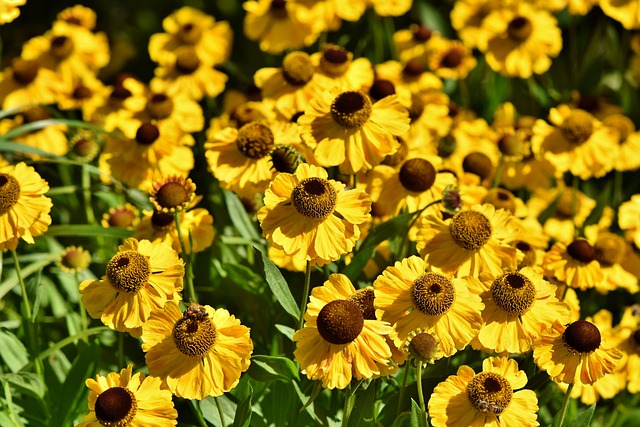A vertical wall garden is a space-efficient and innovative solution for incorporating greenery into limited spaces, offering both aesthetic appeal and functional benefits. The success of such a garden depends on its location's sunlight exposure, the type of support system used, and the selection of plants that thrive in a vertical setup, like climbing ivies or roses. Maintaining these gardens involves lightweight, well-draining soil mixes, efficient watering systems tailored to plant needs, and regular pruning for health and appearance. Seasonal adjustments are essential, with more frequent watering in summer and protection against frost in winter. Fertilization should be species-specific, with a balance of liquid and granular fertilizers enriched with organic matter to support plant growth and microbial diversity. Regular monitoring for signs of stress, pests, or nutrient deficiencies is necessary to ensure the wall garden remains lush and vibrant throughout the year.
Vertical gardens offer a space-saving solution for cultivating a lush, vibrant garden, regardless of your living environment. This article delves into expert advice on optimizing your vertical wall garden’s care. From tailored watering regimens to selecting the right nutrient-rich soil and fertilization plans, learn how to sustain plant health in these innovative systems. Additionally, discover the importance of regular pruning and maintenance for a thriving vertical garden, as well as seasonal adaptations to ensure your greenery flourishes all year round. Whether you’re an urban dweller or a country homeowner, elevate your gardening skills with insights from this comprehensive guide on caring for your wall garden.
- Optimizing Space with Vertical Wall Gardens: A Comprehensive Guide
- Watering Wisely: Tailored Hydration Strategies for Your Wall Garden
- Nutrient-Rich Soil and Fertilization Plans: Sustaining Plant Health in Vertical Systems
- Pruning and Maintenance: Keeping Your Vertical Wall Garden Lush and Productive
- Seasonal Considerations: Adapting Your Wall Garden Care to Temperature Fluctuations and Seasons
Optimizing Space with Vertical Wall Gardens: A Comprehensive Guide

Vertical wall gardens are a space-efficient solution for those with limited outdoor areas or who wish to maximize their growing potential in small spaces. By utilizing vertical space, gardeners can cultivate a variety of plants, creating a lush, green oasis that also serves as an attractive decorative element. Choosing the right location is key; ensure your wall garden receives ample sunlight for photosynthesis, and consider the orientation of your structure to maximize light exposure throughout the day. The type of support system you select, whether it’s a trellis, lattice, or a series of hanging planters, will dictate the types of plants suitable for your vertical garden.
Incorporating a diverse range of climbing plants like ivies, clematis, or climbing roses can add depth and texture to your wall garden. These plants not only enhance the aesthetic appeal but also contribute to the vertical expansion of your greenery. The soil and irrigation systems used in wall gardens should be carefully selected for their efficiency and ability to maintain plant health. Lightweight soilless mixtures are often preferred due to their ease of handling and reduced weight, which is particularly beneficial for hanging planters. Proper watering is essential; consider installing a drip irrigation system to ensure consistent moisture delivery without over saturating the plants or walls. Regular maintenance and pruning will maintain the health and vitality of your vertical wall garden, ensuring it remains a vibrant and flourishing addition to your living space.
Watering Wisely: Tailored Hydration Strategies for Your Wall Garden

Vertical gardens are a space-efficient and aesthetically pleasing way to introduce greenery into compact spaces. To maintain a healthy wall garden, watering is a critical aspect that requires careful consideration. Overwatering can lead to root rot, while underwatering will cause plants to wilt and potentially die. It’s crucial to understand the specific water needs of each plant species in your garden. Generally, vertical gardens should be watered more frequently than traditional gardens due to the limited soil volume and increased evaporation from exposed roots and leaves. A consistent watering schedule that allows the soil to become slightly dry between sessions is optimal for most plants. Investing in a high-quality watering system designed for vertical gardens can help distribute water evenly, ensuring each plant receives the right amount of hydration. Utilize moisture sensors or a timer-based irrigation system to automate this process and alleviate the need for constant manual intervention, promoting consistent growth and vitality in your wall garden.
When watering your vertical garden, aim to saturate the soil completely but without causing runoff. This can be achieved by watering at a slower rate over a longer period, allowing water to penetrate deeply rather than pooling on the surface. Early morning or late evening are ideal times for watering, as temperatures are cooler and evaporation rates are lower. Additionally, consider the orientation of your wall garden; if it receives full sun, you may need to water more frequently to compensate for the increased evaporation rate. Regularly inspect your vertical garden for signs of moisture stress, such as drooping leaves or dry soil, to adjust your watering schedule accordingly and maintain a thriving vertical oasis.
Nutrient-Rich Soil and Fertilization Plans: Sustaining Plant Health in Vertical Systems

Maintaining a thriving vertical garden requires careful consideration of soil health and fertilization to support robust plant growth. The foundation of a healthy vertical garden is nutrient-rich soil. Soil composition plays a pivotal role in the absorption of essential nutrients; it should be well-draining yet retentive enough to hold moisture and deliver vital elements like nitrogen, phosphorus, and potassium to your plants. A balanced soil mix, often a blend of compost, topsoil, and perlite or vermiculite, can provide an ideal growing medium for your wall garden, ensuring that the roots have access to a wealth of nutrients necessary for their development.
Regular fertilization is key to complement the soil’s nutrient profile. A well-planned fertilization schedule will supply your plants with the right balance of macronutrients and micronutrients throughout different growth stages. Liquid or slow-release granular fertilizers can be applied in a vertical garden, tailored to the specific needs of each plant species. For instance, leafy greens tend to favor high nitrogen content, while fruiting plants might require more phosphorus to set fruit. Organic options like fish emulsion or worm castings can enrich the soil and introduce beneficial microorganisms that enhance nutrient uptake, promoting a self-sustaining ecosystem within your vertical garden wall. Monitoring the health of your plants regularly will help you fine-tune your fertilization strategy, ensuring lush, vibrant greenery throughout the growing season.
Pruning and Maintenance: Keeping Your Vertical Wall Garden Lush and Productive

Maintaining a lush and productive vertical wall garden involves regular pruning and diligent care. Pruning is an essential practice that promotes plant health by removing dead or diseased growth, encouraging new, vigorous growth, and shaping the garden for aesthetic purposes. It’s important to use sharp, clean tools to make precise cuts just above a node where leaves or flowers attach to stems, ensuring the plant can direct energy to developing areas. Regularly inspecting your vertical garden for any signs of stress or pests is crucial; addressing these issues promptly will prevent larger problems from arising.
A consistent watering schedule tailored to the specific needs of each species in your wall garden is vital for maintaining its lushness. Overwatering can lead to root rot, while underwatering will cause plants to wilt and lose vitality. A balanced diet with the right balance of nutrients is equally important; fertilize your vertical garden according to the manufacturer’s recommendations or based on soil test results to ensure optimal growth. Additionally, ensuring that your wall garden receives adequate light, either from natural sunlight or supplemental grow lights, will help maintain its vibrancy and productivity throughout the year.
Seasonal Considerations: Adapting Your Wall Garden Care to Temperature Fluctuations and Seasons

Maintaining a healthy vertical garden requires attentive care that adapts to the changing seasons and temperature fluctuations. As the weather shifts from the warmth of summer to the chill of autumn, or from the frosty winter months to the blooming spring, plants have distinct needs. For instance, during hotter periods, it’s crucial to keep the garden well-watered to prevent dehydration and scorching. Conversely, in colder seasons, protecting your wall garden from freezing temperatures is paramount. This can involve insulating the structure or relocating sensitive plants indoors. Additionally, adjusting the position of your vertical garden to receive optimal sunlight throughout the day can help maintain plant health and vitality regardless of the season. Utilizing shade cloth or planting in such a way that sun-loving species are positioned for morning light while shade-tolerant varieties receive afternoon sun can make a significant difference in the overall well-being of your garden. Regular monitoring of soil moisture and nutrient levels is essential year-round, ensuring that each season brings out the best in your vertical garden.
Vertical gardens offer a space-efficient and aesthetically pleasing solution for incorporating greenery into any environment. This article has provided a detailed overview of vertical garden care, from optimizing space to tailoring hydration, ensuring soil vitality, maintaining lushness through pruning, and adapting to seasonal changes. By following the expert advice on watering wisely, nutrient-rich soil upkeep, and regular maintenance, your wall garden can thrive and remain a focal point of health and beauty in your home or community space. Remember to stay attuned to your plants’ needs throughout the year to keep your vertical garden flourishing.
